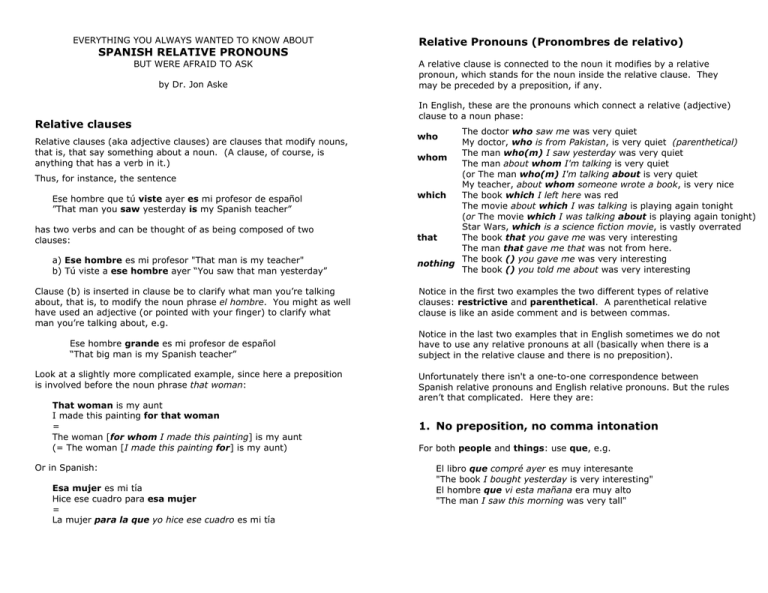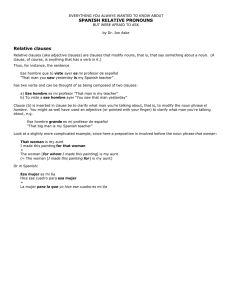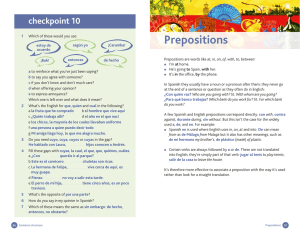Relative Pronouns
Anuncio

EVERYTHING YOU ALWAYS WANTED TO KNOW ABOUT SPANISH RELATIVE PRONOUNS BUT WERE AFRAID TO ASK by Dr. Jon Aske Relative clauses Relative clauses (aka adjective clauses) are clauses that modify nouns, that is, that say something about a noun. (A clause, of course, is anything that has a verb in it.) Thus, for instance, the sentence Ese hombre que tú viste ayer es mi profesor de español ”That man you saw yesterday is my Spanish teacher” has two verbs and can be thought of as being composed of two clauses: a) Ese hombre es mi profesor "That man is my teacher" b) Tú viste a ese hombre ayer “You saw that man yesterday” Clause (b) is inserted in clause be to clarify what man you’re talking about, that is, to modify the noun phrase el hombre. You might as well have used an adjective (or pointed with your finger) to clarify what man you’re talking about, e.g. Ese hombre grande es mi profesor de español “That big man is my Spanish teacher” Look at a slightly more complicated example, since here a preposition is involved before the noun phrase that woman: That woman is my aunt I made this painting for that woman = The woman [for whom I made this painting] is my aunt (= The woman [I made this painting for] is my aunt) Or in Spanish: Esa mujer es mi tía Hice ese cuadro para esa mujer = La mujer para la que yo hice ese cuadro es mi tía Relative Pronouns (Pronombres de relativo) A relative clause is connected to the noun it modifies by a relative pronoun, which stands for the noun inside the relative clause. They may be preceded by a preposition, if any. In English, these are the pronouns which connect a relative (adjective) clause to a noun phase: The doctor who saw me was very quiet My doctor, who is from Pakistan, is very quiet (parenthetical) The man who(m) I saw yesterday was very quiet whom The man about whom I'm talking is very quiet (or The man who(m) I'm talking about is very quiet My teacher, about whom someone wrote a book, is very nice which The book which I left here was red The movie about which I was talking is playing again tonight (or The movie which I was talking about is playing again tonight) Star Wars, which is a science fiction movie, is vastly overrated that The book that you gave me was very interesting The man that gave me that was not from here. The book () you gave me was very interesting nothing The book () you told me about was very interesting who Notice in the first two examples the two different types of relative clauses: restrictive and parenthetical. A parenthetical relative clause is like an aside comment and is between commas. Notice in the last two examples that in English sometimes we do not have to use any relative pronouns at all (basically when there is a subject in the relative clause and there is no preposition). Unfortunately there isn't a one-to-one correspondence between Spanish relative pronouns and English relative pronouns. But the rules aren’t that complicated. Here they are: 1. No preposition, no comma intonation For both people and things: use que, e.g. El libro que compré ayer es muy interesante "The book I bought yesterday is very interesting" El hombre que vi esta mañana era muy alto "The man I saw this morning was very tall" 2. With no preposition (or A personal) AND with comma intonation (parenthetical remark; aside comment) 1. Things or people: use either a) que (recommended) b) el/la/los las cual(es) (fancier, used in writing more) Mi libro, que lo compré ayer, no tiene fotografías Mi libro, el cual lo compré ayer, no tiene fotografías My book, which I bought yesterday, doesn't have pictures Mi hermano, que vio esa película, dice que es interesante = Mi hermano, el cual vio esa película, dice que es interesante "My brother, who saw that movie, says it's very interesting" (Notice that with parentheticals we need the object pronoun inside the relative clause; not so in regular relative clauses.) 2. la camisa verde y la (camisa) roja el libro de Juan y el (libro) de Lucía el libro que compré y el (libro) que vendí. Sometimes the predictability comes from the general context, not from the immediately preciding text, e.g. los ricos “the rich” (understood: los hombres ricos) los guapos (understood: los (hombres (y mujeres)) guapos) One special case is when the modifier is a relative clause: el que estudia, saca buenas notas los que estudian, sacan buenas notas. (said in class; understood: el estudiante que estudia …) This is equivalent to the one(s) who studies, those who study Mi hermano, quien vio esa película, dice que es interesante A fancier alternative to this el/la/los/las que in these ‘headless relative clauses’ is quien(es). For things or people: you can use either a) el/la/los/las que (In some cases, typically with short prepositions, the article can be left out, but it is safer to just leave it in) Estas es la pluma con (la) que escribo mis cartas Esta es la chica para la que escribí la carta b) el/la/los las cual(es) (fancier) Estas es la pluma con la cual escribo mis cartas Esta es la chica para la cual escribí la carta 2. Spanish allows the dropping of a predictable noun in a noun phrase when there is an article and a modifier (adjective, prepositional phrase, or relative clause): People: use quien(es) (fancier, used in writing more) 3. With preposition or A personal (with or without comma intonation) 1. Headless Relative Clauses For people only, you can also use quien(es) (fancier) Esta es la chica para quien escribí la carta NB: In English the preposition may be left at the end of the relative clause, e.g. That’s the pen (that) I write my letters with (as opposed to That’s the pen with which I write my letters). That is not possible in Spanish. The preposition MUST go with the relative pronoun. Quien estudia, saca buenas notas Quienes estudian, sacan buenas notas.. A variant of this is used when you are talking about things (not people) non-committal about the gender of the thing you are talking about, namely use lo instead of el/la/los/las. lo bueno the good thing/part, what’s good (but not = ‘the good one’, which would be el bueno/la buena) lo que quiero what I want; the thing that I want (but not ‘the one I want’, which would be el/la que quiero)









